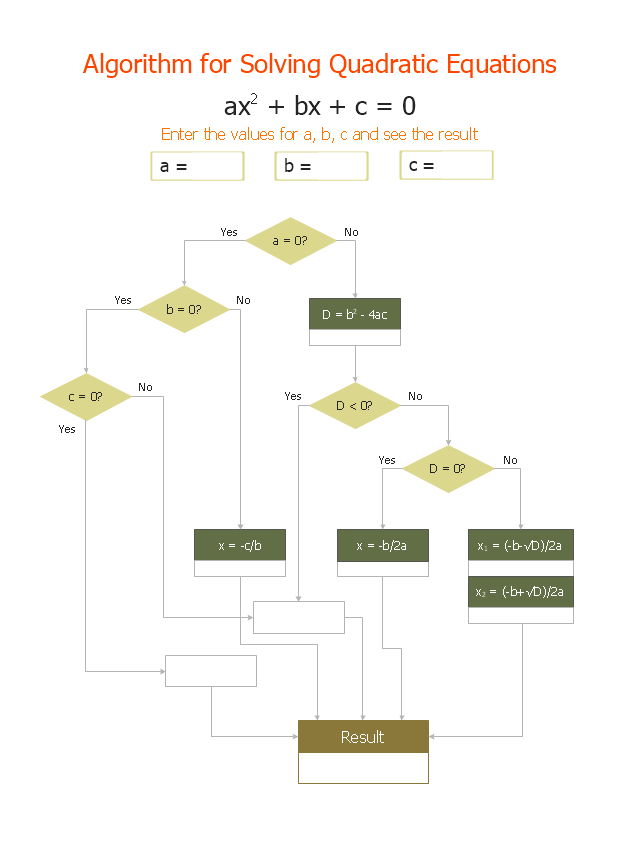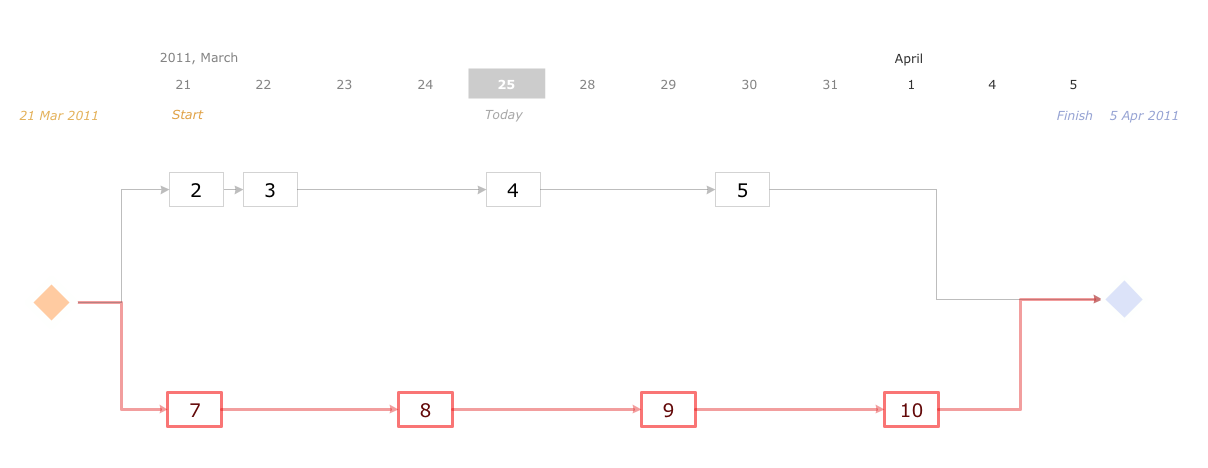"In elementary algebra, a quadratic equation (from the Latin quadratus for "square") is any equation having the form
ax^2+bx+c=0
where x represents an unknown, and a, b, and c are constants with a not equal to 0. If a = 0, then the equation is linear, not quadratic. The constants a, b, and c are called, respectively, the quadratic coefficient, the linear coefficient and the constant or free term.
Because the quadratic equation involves only one unknown, it is called "univariate". The quadratic equation only contains powers of x that are non-negative integers, and therefore it is a polynomial equation, and in particular it is a second degree polynomial equation since the greatest power is two.
Quadratic equations can be solved by a process known in American English as factoring and in other varieties of English as factorising, by completing the square, by using the quadratic formula, or by graphing." [Quadratic equation. Wikipedia]
The flowchart example "Solving quadratic equation algorithm" was created using the ConceptDraw PRO diagramming and vector drawing software extended with the Mathematics solution from the Science and Education area of ConceptDraw Solution Park.
ax^2+bx+c=0
where x represents an unknown, and a, b, and c are constants with a not equal to 0. If a = 0, then the equation is linear, not quadratic. The constants a, b, and c are called, respectively, the quadratic coefficient, the linear coefficient and the constant or free term.
Because the quadratic equation involves only one unknown, it is called "univariate". The quadratic equation only contains powers of x that are non-negative integers, and therefore it is a polynomial equation, and in particular it is a second degree polynomial equation since the greatest power is two.
Quadratic equations can be solved by a process known in American English as factoring and in other varieties of English as factorising, by completing the square, by using the quadratic formula, or by graphing." [Quadratic equation. Wikipedia]
The flowchart example "Solving quadratic equation algorithm" was created using the ConceptDraw PRO diagramming and vector drawing software extended with the Mathematics solution from the Science and Education area of ConceptDraw Solution Park.
Activity Network (PERT) Chart
Activity Network and Project Evaluation and Review Technique, or PERT, charts are a way of documenting and analyzing the tasks in a project.This diagram is constructed as part of the process in creating a schedule of corrective actions. The Activity Network Chart (PERT) shows the logical connections and consequence of tasks to be performed. It displays the time period for problem solving and the implementation of all activities through the critical path.
- Algorithm And Flowchart To Find Roots Of Quadratic Equation
- Draw A Flowchart To Find The Root Or A Lineare Equation Of
- Draw A Flowchart To Find A Root Of A Line Equation Of Degree
- Flow Chart For Finding The Roots Of Quadratic Equation
- Draw A Flowchart To Find Out The Roots Of A Quadratic Equation
- Write A Flowchart To Find The Roots Of The Quadratic Equation
- Examples Of Flowchart To Find Quadratic Equation
- Solving quadratic equation algorithm - Flowchart | Basic ...
- Solving quadratic equation algorithm - Flowchart | Best ...
- Flow Chart To Find The Quadratic Equation
- Draw A Flow Chart To Calculate
- Flowchart For Algorithms Finding Quadratic Equation
- Draw Flowchart To Compute The Roots Of A Quadratic Equation
- Chemistry Equation Symbols | Basic Diagramming | Chemistry ...
- Basic Flowchart Symbols and Meaning | Contoh Flowchart | Solving ...
- Mathematics Symbols | Basic Diagramming | Draw Company ...
- Solving quadratic equation algorithm - Flowchart | Process ...
- Logical network diagram - Vector stencils library | LDAP - Vector ...
- Purchasing Flowchart - Purchase Order. Flowchart Examples | Steps ...
- Mathematics | Mathematical Diagrams | Basic Diagramming ...

